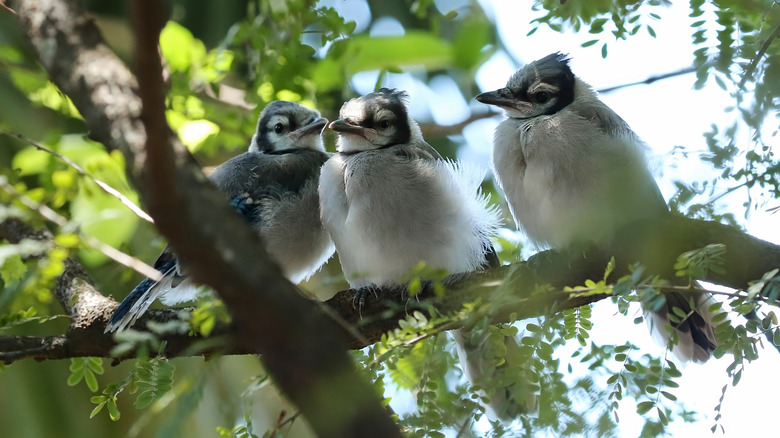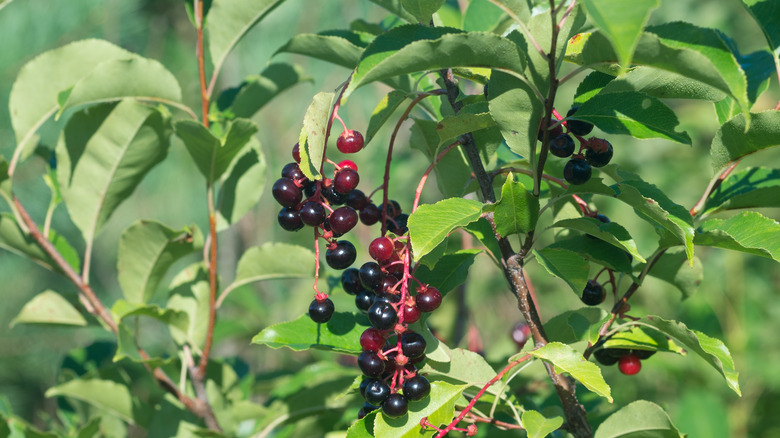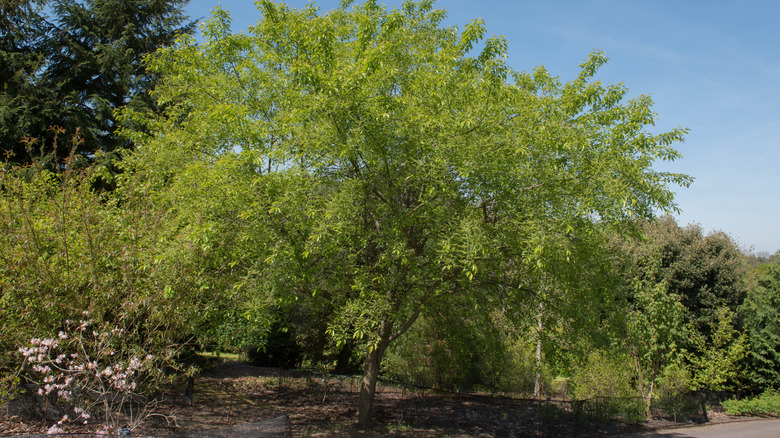The Fast-Growing Tree That Pollinators And Birds Can't Get Enough Of
Do you have a tree in your yard with bark that looks like burned cornflakes? You're lucky to have a mature black cherry. These forest trees, native to the Americas, are beautiful with their dark trunks, sweeping elongated limbs and leaves, explosive fragrant white spring-summer blossoms, and vibrant red-orange fall foliage. For wildlife lovers, it's even more exciting. Every part of the black cherry tree, from the flowers to the pea-sized namesake fruit to the bark, offers food and shelter to birds, insects, and mammals. Cultivating this tree is one of the best ways to bring more birds to your yard during fall ... or any other season.
Some gardeners consider the black cherry (Prunus serotina) a weed — perhaps unfairly so, given its status as a keystone species. The tree is a prolific spreader. Birds and other animals eat the fruit, digesting the seeds and depositing them far from the parent tree. Indeed, black cherry saplings pop up in any free space: open pastures or neglected areas in a backyard or garden. The plant needs space, too. Unpruned black cherries can grow 60 feet tall and 30 feet wide. They don't start producing drupes (the so-called "cherries") for a decade and can live for over 200 years. It's most commonly called black cherry, but in some parts of the U.S., gardeners may know it as the wild or mountain black cherry, wild cherry, or rum cherry (Appalachian Americans traditionally used the fruit to flavor spirits).
Birds and butterflies
Black cherry trees are a boon for bird lovers, attracting over 40 species of birds with their juicy drupes in the fall, bitter as they are — from mockingbirds, woodpeckers, and the humble sparrow to grouse and wild turkeys. Of course, your feathered visitors will vary depending on where in the U.S. you are. For example, Cleveland.com bird watcher and columnist James McCarty found his black cherry tree attracted robins in droves. Detroit birder and Eliza Howell Park guide Leonard Weber wrote about spotting American robins and cedar waxwings eating the fruit in his blog, Eliza Howell Nature Walks. The trees make perfect nesting sites for cavity-nesting birds like orioles, gnatcatchers, and bluebirds. Adult birds — and, interestingly, bats — also pick off the native caterpillars born on the branches; they make a high-calorie meal for hungry chicks.
Well over 400 species of American butterflies and moths lay eggs on black cherry tree leaves and branches and feed on the pollen and nectar produced by the plant's abundant spring flowers. Some of the more common species include Eastern tiger swallowtails, various species of sphinx moth, scalloped sallows, dowdy pinions, red-spotted purples, Columbia silkmoth, and the Promethea moth. Enter your zip code into the National Wildlife Federation's Native Plant Finder to see which species inhabit your area. Butterflies have been known to seek shelter from winter winds and colder temperatures in the crevices between bark flakes. In the same season, caterpillars — like red-spotted admiral larvae — curl leaves into cigar-like homes.
Grow a black cherry
Black cherry trees are insect-pollinated; their blooms attract native bees, flies, and beetles. The tree's stems boast extrafloral nectaries that provide an additional food source for ants; they, in turn, protect the tree from insect predation. Mammals tiny and enormous — from chipmunks and opossums to deer and black bears — dine on the drupes and voles nibble on the bark in winter. However, this seemingly life-elixir plant does have a few downsides. Proceed with caution if you have livestock; they can't tolerate the toxins — cyanide-producing cyanogenic glycosides — found in black cherry leaves, twigs, bark, and seeds (though not the fruit's flesh). Plus, the fruit drops often, leaving red-black stains wherever it lands, be it on city footpaths or your recently water-blasted driveway.
If you live in USDA Hardiness Zones 3 to 9, a black cherry tree is one of the best plants for your pollinator garden. Don't dig up or transplant a volunteer shrub. The plant develops long taproots that, if damaged, don't regrow easily. It's better to buy seeds or saplings from a nursery — like a 1 to 2-inch bare-root seedling for $11.95 from Food Forest Nursery or a 1-gallon option for $24.97 from Vincent Gardens. Plant your black cherry sapling in the spring or fall and think carefully about where. Even with pruning, these trees get big, so the first hole you dig should be the forever spot. Black cherries prefer acidic, moist, well-draining soil and lots of sun. Finally, the trees are drought-friendly, requiring little watering once established.


